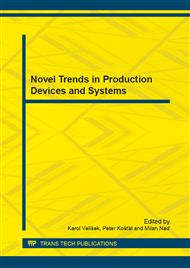[1]
J G Weisser Söhne GmbH & Co: Patent Anmeldung, St. Georgen, Swartzwald, Germany (2004).
Google Scholar
[2]
F. Klocke, T. Bergs, F. Degen: Presentation of a novel cutting technology for precision machining of hardened, rotationally symmetric parts. Production Engineering (ISSN: 0944-6524), Vol. 7, Issue 2-3, pp.177-184 (2013).
DOI: 10.1007/s11740-012-0438-y
Google Scholar
[3]
G. Varga: Effects of Technological Parameters on the Surface Texture of Burnished Surfaces, Key Engineering Materials (ISSN 1013-9826), Vol. 581: Precision Machining VII, pp: 403-408 (2014).
DOI: 10.4028/www.scientific.net/kem.581.403
Google Scholar
[4]
J. Pilc, K. Vasilko: Development and applications of a rotating turning tool. Manufacturing Technology (ISSN: 1213-2489), Vol. 13, Issue 2, pp.226-231 (2013).
DOI: 10.21062/ujep/x.2013/a/1213-2489/mt/13/2/226
Google Scholar
[5]
J. Beno, I. Manková, M. Vrabel, D. Kottfer: Roughness measurement methodology for selection of tool inserts (2013). Measurement 46, pp.582-592.
DOI: 10.1016/j.measurement.2012.08.017
Google Scholar
[6]
I. Sztankovics, J. Kundrák: Theoretical value of total height of profile in rotational turning, Applied Mechanics and Materials (ISSN: 1662-7482), Vol 309 (III Central European Conference on Logistics), pp.154-161 (2013).
DOI: 10.4028/www.scientific.net/amm.309.154
Google Scholar
[7]
J. Kundrák, K. Gyáni, I. Deszpoth, I. Sztankovics: Material removal characteristics in rotational and tangential turning, Cutting & Tool in Technological System (ISSN 2078-7405), Vol 82, pp.109-116 (2012).
DOI: 10.20998/2078-7405.2023.98.11
Google Scholar
[8]
F.L. Litvin, A. Fuentes: Gear Geometry and Applied Theory (second ed. ), Cambridge University Press, p.800 (2004).
Google Scholar
[9]
R. Siecla, S. Legutko: Gear-Shaper Cutter with Curvilinear Side Flank Face. Manufacturing Technology (ISSN: 1213-2489), Vol. 12, No. 13, pp.233-237 (2012).
DOI: 10.21062/ujep/x.2012/a/1213-2489/mt/12/2/233
Google Scholar
[10]
E. Faluvégi: Research on methods of measuring geometric parameters of the gears, Ph.D. dissertation (in Romanian), Transilvania University of Brasov, p.224 (2012).
Google Scholar
[11]
K. Vasilko: Kinematics Analysis of the movement of cutting tool against the workpiece and creation of new schemes, Manufacturing and industrial engineering Kosice pp.8-15 (2010).
Google Scholar
[12]
Z. Balajti, J. Ábel: Applying Projective Geometry in Design of Worm Manufacturing, Key Engineering Materials (ISSN 1013-9826), Vol. 581: Precision Machining VII, pp.77-81 (2014).
DOI: 10.4028/www.scientific.net/kem.581.77
Google Scholar
[13]
I. Sztankovics, J. Kundrák: Mathematical description of machining external cylindrical surface in case of rotational turning, Cutting & Tool in Technological System (ISSN 2078-7405) Vol 82, pp.264-269 (2012).
Google Scholar


